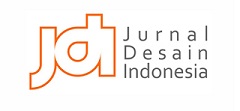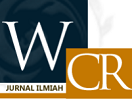PENGARUH VARIASI JENIS DAN KONSENTRASI ZAT FIKSASI PADA EKSTRAK DAUN PEPAYA SEBAGAI PEWARNA ALAMI PADA KAIN BATIK
Abstract
One of the symbols that reflect Indonesian culture is batik. One of the processes of making batik is coloring. The use of traditional dyes is gradually being replaced by chemical dyes. However, chemical dyes can cause some environmental problems. To minimize the impact of environmental pollution, it is possible to reuse natural dyes. Papaya leaves were chosen because they can be used to produce non-food natural dyes by way of processing that is easier and more effective and is available in relatively large quantities. The chlorophyll content in papaya leaves is 13.91 mg/L after spinach leaves, kale leaves, and cassava leaves. Fixation agent is needed in the coloring process in order to suppress the color direction by changing the color intensity according to the type of mordant and variations in its concentration. This study used variations of alum and tunjung with concentrations of (35, 70, and 105) grams. The color quality is proven through the fabric color space test and the color fastness test to dry ironing heat and washing soap. The stages in this study were starting from material preparation, papaya leaf extraction, coloring, fixation, pelorodan, and testing the color space and color fastness. Based on the data obtained, it was concluded that the type and concentration of the optimal fixation agent in papaya leaf extract as a natural dye was the type of fixative agent of tunjung with a concentration of 105 grams.
Keywords
Full Text:
PDF (Bahasa Indonesia)References
Aditya, S. M., Wrasiati, L. P., & Mulyani, S. (2021). Karakteristrik Enkapsulat Pewarna dari Ekstrak Daun Pepaya (Carica papaya L.) pada Perlakuan Perbandingan Gelatin dan Maltodekstrin. Jurnal Rekayasa Dan Manajemen Agroindustri, 9(1), 42–52. https://doi.org/10.24843/jrma.2021.v09.i01.p05
Annafi, N., Wiraningtyas, A., & R, R. (2019). Perbandingan Metode Ekstraksi Zat Warna Dari Rumput Laut Sargassum sp. Jurnal Redoks : Jurnal Pendidikan Kimia Dan Ilmu Kimia, 3(1), 13–17. https://doi.org/10.33627/re.v3i1.243
Azizah, E., & Hartana, A. (2018). Pemanfaatan Daun Harendong (Melastoma malabathricum) Sebagai Pewarna Alami Untuk Kain Katun. Dinamika Kerajinan Dan Batik: Majalah Ilmiah, 35(1), 1. https://doi.org/10.22322/dkb.v35i1.3490
Azizah, H. P., & Utami, B. (2016). Pemanfaatan Zat Warna Hijau Dari Daun Pepaya (Carica papaya L .) Sebagai Pewarna Alami Tekstil. Seminar Nasional Kimia UNY, 5(October 2016), 1–13.
Ebid, E., & Atmojo, W. T. (2020). Pewarnaan Kain Ikat Celup Menggunakan Bahan Alami Daun Jambu Biji (Psidium Guajaval) Di Sanggar Seni Pendopo. Gorga : Jurnal Seni Rupa, 9(2), 377. https://doi.org/10.24114/gr.v9i2.21109
Haerudin, A., Arta, T. K., Masiswo, Fitriani, A., & Laela, E. (2020). Pengaruh Frekuensi Pencelupan Dengan Metode Simultan Terhadap Nilai Uji Ketuaan Warna, Ruang Warna Dan Ketahanan Luntur Warna Yang Dihasilkan Pada Batik Menggunakan Ekstrak Kulit Buah Jalawe (Terminalia bellirica (gaertn) Roxb). Dinamika Kerajinan Dan Batik: Majalah Ilmiah, 37(2), 195–206. https://doi.org/10.22322/dkb.V36i1.4149
Haerudin, A., & Atika, V. (2021). Sebagai Zat Warna Alami Untuk Pewarnaan Kain Batik Katun Dan Sutera. Simposium Nasional RAPI XX, 1(1), 1–9.
Ikhsanti, N. T., & Hendrawan, A. (2020). Pengolahan Pewarna Alami Indigo Dengan Teknik Cap Pelepah Pisang Pada Produk Busana. E-Proceeding of Art & Design, 7(2), 3554–3566.
Kurnia, R. (2013). Pusat Studi Batik Universitas Cokroaminoto. CORAK Jurnal Seni Kriya, 2(1), 47–56.
Minarno, A. E., Maulani, A. S., Kurniawardhani, A., Bimantoro, F., & Suciati, N. (2018). Comparison of methods for Batik classification using multi texton histogram. Telkomnika (Telecommunication Computing Electronics and Control), 16(3), 1358–1366. https://doi.org/10.12928/TELKOMNIKA.v16i3.7376
Nabilasari, R. R., & Widihastuti. (2021). Pengaruh Formula Pencampuran Zat Warna Indigosol Yang Dihasilkan Pada Pencelupan Kain. Prosiding Pendidikan Teknik Boga Busana, 16(1), 1–9.
Pringgenies, D., Supriyantini, E., Azizah, R., Hartati, R., Irwani, & Radjasa, O. K. (2017). Aplikasi Pewarnaan Bahan Alam Mangrove Untuk Bahan Batik Sebagai Diversifikasi Usaha Di Desa Binaan Kabupaten Semarang. Info, 15(1), 1–9.
Purwanto. (2018). Pemanfaatan Bahan Pewarna Alam Sebagai Alternatif dalam Pembuatan Batik Tulis yang Ramah Lingkungan. Prosiding Seminar Nasional Aplikasi Sains & Teknologi (SNAST), 2(September), 317–324.
Ramadhan, F. H., Dewi, E. N., & Anggo, A. D. (2020). Pengaruh perbedaan konsentrasi ekstrak pewarna alami rumput laut (Sargassum sp.) terhadap mutu warna kain katun batik. Jurnal Ilmu Dan Teknologi Perikanan, 2(2), 42–49.
Rohmawati, T., & Kusumastuti, A. (2019). Potensi Gulma Babandotan (Ageratum Conyzoides L.) sebagai Pewarna Alam Kain Katun Primissima Menggunakan Mordan Jeruk Nipis, Tawas, Kapur Tohor, dan Tunjung. TEKNOBUGA: Jurnal Teknologi Busana Dan Boga, 7(2), 133–138. https://doi.org/10.1529/jtbb.v7i2.21356
Rusdi, S., Maulana, H. F., Samudro, N. L., & Chafidz, A. (2020). Investigating the potential use of papaya leaf extract as natural dyes in the textile industry. Materials Science Forum, 991(1), 129–134. https://doi.org/10.4028/www.scientific.net/MSF.991.129
Setiawan, Y., & Wiratma, S. (2021). Coconut husk as a batik coloring material. 4(1), 46–54.
Shaharuddin, S. I. S., Shamsuddin, M. S., Drahman, M. H., Hasan, Z., Mohd Asri, N. A., Nordin, A. A., & Shaffiar, N. M. (2021). A Review on the Malaysian and Indonesian Batik Production, Challenges, and Innovations in the 21st Century. SAGE Open, 11(3), 1–19. https://doi.org/10.1177/21582440211040128
Subekti, P., Hafiar, H., & Komariah, K. (2020). Word Of Mouth Sebagai Upaya Promosi Batik Sumedang Oleh Perajin Batik (Studi Kasus pada Sanggar Batik Umimay). Dinamika Kerajinan Dan Batik: Majalah Ilmiah, 37(1), 41–54. https://doi.org/10.22322/dkb.V36i1.4149
Suryani, T., AS, A., & Prasetyo, A. D. (2020). Kualitas warna alami batik dari daun dan kulit buah beberapa tanaman dengan variasi lama perendaman. Seminar Nasional Pendidikan Biologi Dan Saintek (SNPBS) Ke-V, (1980), 573–579.
Wulandari, L. O., & Haryanto, a R. (2021). Pengaruh Jenis Mordan Dan Lama Waktu Pencelupan Terhadap Hasil Pewarnaan Pada Kain Mori Primissima Dengan Zat Warna Dari Daun Ketapang Dengan Proses Pra-Mordanting. Prosiding Senimar Nasional Aplikasi Sains Da Tekologi (SNAST), (ISSN:1979-911x), 32–38.
DOI: http://dx.doi.org/10.22441/narada.2022.v9.i3.001
Refbacks
- There are currently no refbacks.
Fakultas Desain dan Seni Kreatif
Universitas Mercu Buana
Gedung E Lantai 4
Jl. Raya Meruya Selatan no.1, Kembangan, Jakarta 11650
Tlp./Fax: +62215871335
Journal International Standard Serial Number (ISSN) Registration:
The Journal is indexed by:
Tools for Citations & Plagiarism Detection:

Ciptaan disebarluaskan di bawah Lisensi Creative Commons Atribusi-NonKomersial 4.0 Internasional
 NARADA: Jurnal Desain dan Seni
NARADA: Jurnal Desain dan Seni

























